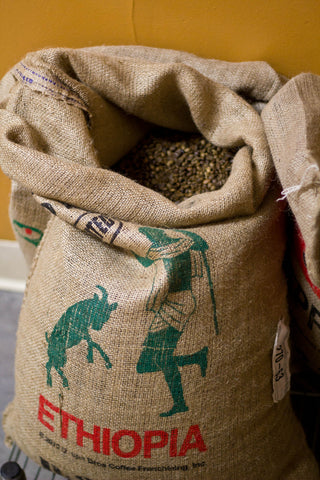- Continue Shopping
- Your Cart is Empty
Burlap Coffee Bags Are Being Used to Make Paper
Coffee roasters and coffee shops across the country go through a large number of large burlap bags, which usually end up in landfills once they are empty, as often they are too worn to be reused. A St. Louis-based inventor named Ted Gast has come up with a way to turn this burlap into specialty papers.
To create his line of papers, Gast has partnered with George A. Whiting Paper Co. in Menasha, Wisconsin. The bags are processed and broken down into their jute and sisal fibers and then turned into specialty papers. The name of the product is Kona Paper, a reference to the variety of coffee that comes from Hawaii.
Kona Paper is currently being used by Caribou Coffee Company for business cards and coffee sleeves as well as by other coffee companies across the country. Gast and the George A. Whiting Paper Co. now plan to start producing scrapbooking papers and other varieties of specialty paper with their recycled burlap fibers.
You can check out the official website here.

UCSB's Paper Towel Free Project Helping to Save Trees
This school year, there is a new push to go paperless at the University of California, Santa Barbara. Called the Paper Towel Free Project, the move is being orchestrated by the he Zero Waste Committee at the university and by the school’s Residence Hall Association.
In two of the campuses' dormitories, environmental floors have had their paper towel dispensers removed from bathrooms. Everyone who lives on the floor was given a reusable hand towel, and there are hooks provided in the lavatories for storing the towels while using the restroom.
The project follows a ban on paper towels in all bathroom residence halls at the University of California, Santa Cruz, a part of the university's plan to produce zero waste by 2020. Paper towels are still being kept in kitchen and laundry areas for use when there are spills or other messes with which to be dealt.
The story of the Paper Towel Free Project as told in The Bottom Line can serve as inspiration for anyone looking to ditch paper towels and establish a paperless kitchen. You can start small; try only using paper towels for emergencies and using a reusable towel or green disposable at other times to get started. Gradually, you can decrease usage for other purposes and eventually switch only to reusables and unpaper towels.

Check out our paper towel alternatives!
University of Illinois Making Their Own Paper

Prairie Grass one of the crops being used to make paper at the University of Illinois
A project called The Fresh Press at The University of Illinois is putting agricultural waste to good use and helping the college save paper. The project is run by two professors and two research assistants.
The team gathers waste from various sources, including the on-campus Sustainable Student Farm. Then, the waste is chipped, soaked, cooked, mixed, screened and pressed into paper. Various projects on campus have made use of the paper produced by the team, and some of their handmade papers are now being used by the university's Book Arts Co-op club.
Funded by the university, The Fresh Press is making good use of waste, protecting trees and spreading an important environmental message. Way to go, U of I!
African Woman Uses Paper Waste to Support Her Family
With 10 children to feed, no husband and no means to find employment, Gabaiphe Tlhaloso of Francistown, Botswana was facing tremendous hardships. The single mother is illiterate, making her prospects seem bleak, but not one to lose hope, she began to brainstorm ways to support herself and her family.
Tlhaloso noticed how much paper waste was discarded around her home, and she became inspired to both clean up her neighborhood and put the waste paper to good use. She experimented and found a way to use old newspaper and boxes mixed with stones, grain husks and sand to make handicrafts.
Her beautiful pieces are intended for decorating her home, and she has set up a small shop at a flea market-type event. To decorate her art, Tlhaloso uses watermelon seeds, pebbles and other found items. Her works sell for $23 to $50, which may not seem like much; however, with her profits, she has been able to move her family of 11 from a one-room home to a two-room home.
Tlhaloso is actively trying to inspire other women in the area to put their skills to use to support her families. Her story is an inspiring one that deserves to be shared.






